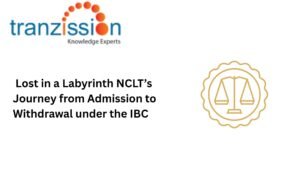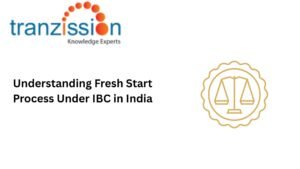
Section 33 of IBC – Insolvency and Bankruptcy Code
Table of Contents
When a company is unable to meet its financial obligations and the Adjudicating Authority has decided that it must be wound up, the company will undergo liquidation proceedings in the Insolvency and Bankruptcy Code, 2016 (“the IBC”). The IBC provisions outline the process for initiating the liquidation of a corporate debtor under certain conditions, which have been listed under Section 33 of IBC. This article delves into the specifications for initiating liquidation in this section, the judicial interpretations on the liquidation process, and any challenges that may arise.
Understanding Section 33 of IBC
What is Liquidation Under IBC?
Liquidation is the process of winding up a corporate debtor, involving selling its assets and distributing its proceeds among creditors as per the priority established under Section 53. The primary goal of liquidation under IBC is to maximise the asset value of the corporate debtor while balancing creditor interests to ensure the debtor ‘ends’ without further disputes.
When Does Liquidation Begin?
Section 33 of IBC lists certain conditions in which the liquidation process is initiated:
- The corporate debtor fails to submit a resolution plan before the insolvency resolution process period ends.
- The NCLT rejects the resolution plan.
- The resolution professional (RP) informs the NCLT of the CoC’s decision to liquidate the company, which must be decided by 66% of the voting share.
- The corporate debtor has contravened the terms of the resolution plan.
Key Aspects of Section 33 of IBC
This provision mentions the importance of three factors that are important, namely:
Role of the Adjudicating Authority:
The NCLT acts as the Adjudicating Authority and is responsible for initiating the liquidation process and overseeing the entire process. The NCLT also appoints the liquidator to manage the affairs of the corporate debtor during liquidation once the order is passed under section 33(7).
Suggested Reading : Section 9 of IBC – Insolvency and Bankruptcy Code, 2016
Automatic liquidation in the absence of a resolution plan:
Section 33(1)(a) mandates that if no resolution plan has been received before the expiry of the insolvency resolution process period or the maximum period permitted for completion of the resolution process. Therefore, the corporate debtor and creditors must submit a viable resolution plan 330 days before the insolvency commencement date.
Continuation of Moratorium:
Once the liquidation order has been passed, no suit or other legal proceeding can be instituted by or against the corporate debtor. As per this section, the moratorium declared in section 14 continues during liquidation to protect the corporate debtor’s assets from additional claims or litigation.
Step-by-Step Procedure for Liquidation Under Section 33 of IBC
Step 1: Passing of Liquidation Order
NCLT passes a liquidation order based on the conditions for initiating the liquidation process under section 33(1), (2), and (3).
Step 2: Appointment of Liquidator
When the NCLT passes a liquidation order for the corporate debtor, the RP appointed for the corporate insolvency resolution process (CIRP) acts as the liquidator for the purposes of liquidation. This liquidator may be replaced by the NCLT if the resolution plan submitted by the RP is rejected, the Insolvency and Bankruptcy Board of India (IBBI) recommends the replacement of RP to the NCLT, the RP fails to submit written consent to act as liquidator. The
Step 3: Public Announcement
The liquidator makes a public announcement in Form B of Schedule II within 5 days from his appointment as per Regulation 12 of the Insolvency and Bankruptcy Board of India (Liquidation Process) Regulations, 2016 (hereon forward known as “the Regulations, 2016”).
Step 4: Verification of Claims
According to the liquidator’s duties in section 35 of the IBC, the liquidator must verify and categorise the claims as per section 53 of the IBC. The liquidator receives or collects the claims for the creditors within 30 days from the date of commencement of the liquidation process. As per section 39 and Regulation 30 of the Regulations, 2016, the liquidator verifies the claims submitted within 30 days from the last date for receipt of claims and may either admit or reject the claim, in whole or in part.
Step 5: Sale of Assets
The liquidator involves selling the corporate debtor’s assets through public auctions or private sales to maximize value. As per Regulation 32, the liquidator may sell an asset on a standalone basis, the assets in a slump sale, a set of assets collectively, the assets in parcels, the corporate debtor as a going concern, or the business of the corporate debtor as a going concern.
Step 6: Distribution of Proceeds
Once the sale of the assets has been completed, the proceeds from the sale are distributed on a priority basis under section 53 of the IBC by the liquidator.
Suggested Reading ; Section 81 of IBC – Insolvency and Bankruptcy Code, 2016
Judicial Interpretations of Section 33 of IBC
The Supreme Court in Swiss Ribbons Pvt. Ltd. v. Union of India upheld the constitutional validity of IBC provisions, emphasizing that liquidation is an essential last resort under the IBC. In Surendra Trading Co. v. Juggilal Kamlapat Jute Mills Co. Ltd, the court clarified the strict adherence to timelines in CIRP to avoid unnecessary delays in liquidation. In K. Sashidhar v. Indian Overseas Bank, the Supreme Court ruled that the NCLT and NCLAT cannot review commercial decisions made by the COC. This case highlighted the CoC’s authority in deciding liquidation and the limited scope of judicial intervention.
Implications of Liquidation for Stakeholders
For Creditors:
As per section 53, the secured creditors are paid first, followed by preferential creditors, and then unsecured creditors. Therefore, the unsecured creditors often receive a much lower percentage of what they are owed, and may not be paid at all.
For Corporate Debtors:
The corporate debtor’s existence is terminated upon the liquidation. Once the assets of the corporate debtor have been completely liquidated, the liquidator shall make an application to the NCLT for the dissolution of such corpraote debtor. Upon this application, the NCLT passes a dissolution order and the corporate debtor is dissolved from the date of that order as per section 54(2).
For Employees and Other Stakeholders:
Section 33(7) states that the liquidation order is deemed to be a notice of discharge to the officers, employees, and workmen of the corporate debtor. Although employees, shareholders, and operational creditors and employees are prioritized in the waterfall mechanism, they face uncertainty due to the legal and financial outcomes of the liquidation process.
Challenges in Implementing Section 33
Delays in the Liquidation Process:
The liquidation process can be delayed because of procedural inefficiencies in asset identification, valuation, and sale. Court backlogs, a shortage of manpower at the NCLT benches, and a lack of effective coordination among creditors can also delay the process.
Limited Asset Recovery:
The liquidator may find challenges in maximising the asset value of the corporate debtor, particularly for stressed or depreciated assets. This could be because the assets are outdated and legal disputes which depreciate the assets.
Stakeholder Disputes:
Secured creditors often receive full payment under section 53, meaning that unsecured creditors are left unpaid. This leads to disputes among creditors over claims and distributions during liquidation.
Recommendations for Strengthening Liquidation Processes
It is recommended that the IBBI issue standardized valuation frameworks to ensure an accurate assessment of the corporate debtor’s assets.
By introducing technology-driven tools for efficient claim verification, asset management, and reporting, there may be a significant reduction in the liquidation process.
The IBBI should introduce training and certification programs to enhance the expertise of insolvency professionals handling liquidation cases.
It suggested establishing pre-packaged liquidation schemes to simplify and expedite the process.
Comparative Analysis: Liquidation Frameworks in Other Jurisdictions
To avoid delays and simplify the liquidation process under the IBC, India can learn from the liquidation framework in the United States and the United Kingdom. The approach of the US under Chapter 7, is the process where a debtor’s non-exempt assets are liquidated to pay off creditors, meaning that the company ceases operations and is completely dissolved. On the other hand, the IBC offers a more flexible approach that involves liquidation, similar to Chapter 7, but also includes options for corporate restructuring and debt repayment plans. The UK Insolvency framework has more creditor-in-control, meaning that creditors have significant influence over the liquidation process. There are less strict timelines for liquidation, which allows for more flexibility in the process.
Conclusion
Section 33 of IBC governs the initiation of the liquidation process for a corporate debtor. The NLCT is responsible for passing the final liquidation order based on the decision of the CoC. It essentially marks the point where a company is deemed insolvent and its assets are sold off to pay creditors if no viable resolution plan is submitted or the CoC has decided that the debtor must be liquidated. Once the liquidation order is passed under Section 33 of IBC, no new legal proceedings can be initiated against the corporate debtor. The liquidator sells the assets of the corporate debtor, after which the proceeds are distributed among its creditors.





